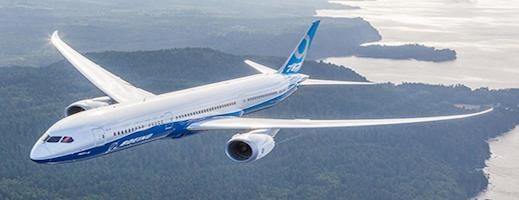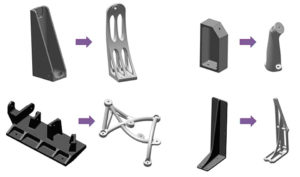Boeing: Additive Manufacturing Adding Enough?

Boeing is a leader in implementing 3d printing processes on commercial airliners. But are they leveraging the benefits of 3d printing enough to reduce costs and manufacture more efficiently?
In April of 2017, Boeing managed to get the FAA to approve the first 3d printed structural titanium parts ever for use in a commercial airliner.[1] Boeing worked hand in hand with Norsk Titanium AS, a specialist 3d printing technology company, to design the process and parts themselves as part of Boeing’s ongoing effort to lower the unit cost of the 787 program, which had been unprofitable up until 2016.[2] Chip Yates, VP of Marketing at Norsk Titanium AS, stated that as result of utilizing 3d printing to create these titanium parts, Boeing expects to realize $2-3 million in savings on what is currently estimated by industry experts to be a $17 million titanium expense per plane (total unit cost of a 787 is estimated to be $265 million).[3] This sounds wonderful as an outcome of leveraging new technology to slash costs, but I would like to know, why are the savings for using 3d printing so low?
Yates gave a clue as to why Boeing only expects to reduce titanium costs $2-3 million in a 2017 Reuter’s article in which he was cited as saying “literal tons” on a 787 could be printed rather than made by traditional forging and machining processes.[4] To me, this screams that in the design of these parts, and the larger use of 3d printing to make them, Boeing only strived to reduce raw material waste in the manufacturing process, without actually leveraging deeper benefits that afforded by 3d printing.
A beauty of 3d printing is that it allows a manufacturer to create a raw stock billet in near net shape, meaning that only minimal material will be scrapped when this printed billet is machined to precise dimensions. Traditional forging can create a similar near net shape stock billet, but is still more wasteful of material (runners for the flow of molten metal generate material waste) and more energy intensive than 3d printing. Boeing apparently has been focused predominantly on this material savings. While such savings are both beneficial to a company’s bottom line and to the environment, they are really just the tip of the iceberg in terms of what 3d printing can really can offer.
3d printing represents a paradigm shift in both manufacturing, and critically, in the design of parts. In any product development, these two elements are inextricably intertwined: design of a part is restricted by the reality of how the part will have to be manufactured. With the development of 3d printing, parts having new geometries than ever before are suddenly both possible and economic to manufacture. This can mean parts might now take a form more similar to what physics and theory dictate they should look like, as opposed to forms that, until 3d printing, were the result of designing to the lowest common denominator of functional requirements while still being manufacturable with traditional processes. 3d printing then offers massive opportunity to design more efficiently, yet on a project with chronically high costs, Boeing is only managing to realize a savings of around a single percent of the overall 787 unit cost with metal 3d printing?[5]
Part of why I’m of the opinion that the cost savings of using 3d printing are too low on the 787 program is because Boeing seems to fully understand all the benefits 3d printing can afford. In a quarterly 2017 Boeing memo published on innovation within the company, Boeing spells out how they “proactively used additive manufacturing” to enable “free form” design of parts that previously could not possibly be produced on a satellite program, and states that to capture all the benefits of 3d printing technology “redesign of the entire system design as a whole” will be necessary.[6] What’s more, Boeing is investing in collaborations and acquisitions of truly cutting-edge 3d printing technology partners, such as Norsk, Oerlikon (a Swiss-based 3d printing developer), and Digital Alloys (a specialist in multi-metal additive manufacturing). [7][8][9]
Examples of parts with similar functionality, but creatively redesigned to utilize 3d printing (Source: Boeing [10])
Boeing comprehends the potential upside of 3d printing, so more than anything, to me the limited cost savings of 3d printing on the 787 come down to a lack of aspiration. Yes, my view of the overall 787 program and associated costs is limited, and I may overestimate the FAA’s willingness to approve the use of additional 3d printed parts in the short term. Nonetheless, 787 subsystems certainly could be redesigned to take full advantage of 3d printing benefits, and over the life of a program as large as the 787 program, I would hope Boeing aspires to rethink the design of much more than just pieces of the 787. To Boeing’s management then I pose the question: how will you design your next plane? Around traditional manufacturing methods, or creatively utilizing all the advantages of 3d printing? (790 words)
Works Cited:
[1] Scott, A. (2018). Printed titanium parts expected to save millions in Boeing…. [online] U.S. Available at: https://www.reuters.com/article/us-norsk-boeing-idUSKBN17C264 [Accessed 14 Nov. 2018].
[2] Ibid.
[3] Ibid.
[4] Ibid.
[5] Ibid.
[6] Aston, R. (2018). Boeing: 3D printing done right. [online] Boeing.com. Available at: https://www.boeing.com/features/innovation-quarterly/nov2017/feature-thought-leadership-3d-printing.page [Accessed 14 Nov. 2018].
[7] Scott, A. (2018). Printed titanium parts expected to save millions in Boeing…. [online] U.S. Available at: https://www.reuters.com/article/us-norsk-boeing-idUSKBN17C264 [Accessed 14 Nov. 2018].
[8] Tate, P. (2018). Boeing’s Additive Ambition – Manufacturing Leadership Council. [online] Manufacturing Leadership Council. Available at: https://www.manufacturingleadershipcouncil.com/2018/05/03/boeings-additive-ambition/ [Accessed 14 Nov. 2018].
[9] Investors.boeing.com. (2018). Boeing HorizonX Ventures Invests in High-Speed Metal 3D Printing Company Digital Alloys. [online] Available at: http://investors.boeing.com/investors/investor-news/press-release-details/2018/Boeing-HorizonX-Ventures-Invests-in-High-Speed-Metal-3D-Printing-Company-Digital-Alloys/default.aspx [Accessed 14 Nov. 2018].
[10] Aston, R. (2018). Boeing: 3D printing done right. [online] Boeing.com. Available at: https://www.boeing.com/features/innovation-quarterly/nov2017/feature-thought-leadership-3d-printing.page [Accessed 14 Nov. 2018].
Cover Photo:
787. 2018. Image. https://www.industryweek.com/finance/boeing-forecasts-21-billion-cost-787-dreamliners-air-tanker.




Very informative and fascinating article, and I definitely agree with you that Boeing is not utilizing the full potential of cost savings that 3D printing can bring to the manufacturing process. However, it’d be interesting to know if safety concerns (given that 3D printing is still a relatively new technology compared to traditional manufacturing processes) is part of the management’s decision to limit the usage of the technology.
Having worked in aircraft design both as a stress engineer (one who predicts part failures) and as project engineer (one who designs the parts), I would caution against suggesting that Boeing under-utilized the 3D-printing technology. Firstly, all materials that go into aircraft have to conform to certain standards (typically an ASTM standard) for physical properties, such as stiffness and strength. Certain parts require stricter standards than others depending on the criticality of the part –think with 99% confidence that the part has a strength of XYZ. These standards are not well known yet for 3D printed materials, making modeling their failures more challenging. This means that certifying them too is more challenging. This leads to the last point about regulation and general conservatism in the aerospace industry. Any deviation from FAA regulations requires working with them to come up with special allowances for certification –this is an arduous process that must be taken on early in the design process. Finally, from the company’s perspective, it’s always better to use parts that share commonality across aircraft in your manufacturing process as you know two things: one, they have been demonstrated to work on other aircraft and two, they are cheaper to build (the suppliers are already set up and you can achieve economies of scale). Hope this provides a bottoms up view of aircraft design and 3d printing! Very exciting post!
Super interesting article about Boeing! I’d be curious to see how some of these learnings and investments in additive manufacturing shows up on your financial statements (hello, program accounting!). I’d be interested to learn how they adapt compliance standards around safety with their quality control and innovation practices. Also, I’ve only worked with 3D printing in the context of plastic resin (basically the ink for 3D printers). I’d be interested to learn how Boeing develops the resins needed to design certain parts of their aircraft.
Very interesting article and coming from a similar capital expenditure intensive industry going through a turbulent market shift, I can fully relate to the author’s frustration on only looking at a smaller dimension of cost reduction vs. realizing bigger potential with 3d printing. However, sometimes taking incremental steps to first realize the roadblocks and challenges before going full swing in implementing change processes can be beneficial. For the airline industry that has a strict regulation for safety factor consideration in material selection, safety parameters, and design choices, maybe there are limiting factors with the 3d printing that are yet to be uncovered or factored in. I was also looking into Boeing’s 3d printing strategy from a different perspective of vendor selection that Boeing is working with. Generally, Scandinavian countries are more expensive to do business in terms of labor or other service costs so I feel it is an interesting choice of partnership especially when the focus in on cost reduction. There are other competitors in the titanium 3d printing marketplace such as Timet or lmiaerospace that can possibly provide higher cost saving synergies considering a majority of Boeing manufacturing facilities are in US. Enjoyed your post! Great work!
Thanks for a very interesting article! It seems that the aerospace industry has been buzzing about the possibilities of additive manufacturing for the past decade, and it has encountered more roadblocks than expected. As BlueSky pointed out, aerospace is an extremely conservative industry given what is at stake. My (limited) understanding of additive manufacturing is that the metal components formed from it don’t have the same strength and fatigue properties as those milled from castings or extrusions because of the incremental way additive manufacturing forms the components. This may make it so that additive manufacturing using metals grows more quickly in other industries before coming to aerospace. Additionally, my sense is that Boeing would be hesitant to introduce new parts on a current platform (i.e. the 787) due to supply chain risks, FAA approval risks, and technology risks. That said, it will be exciting to watch this further develop and be used for future platforms, hopefully as early as the 797.
I wonder if what looks like lack of aspiration is to some extent an effort to set expectations low – I suspect that the implementation of any new technology comes with great risk that cost savings have been mis-forecast (similar to what happened at Fuyao Glass, where the protagonist mentioned they did not accurately anticipate the costs associated with fulfilling the job out of the U.S. facilities). As a company facing a lot of analyst and shareholder scrutiny right now, I wonder if the $2-3m is setting a low bar to clear and avoid further disappointing these audiences.
Very interesting article! I was of the impression that 3D printing cannot produce such delicate items as pieces of the planes. So it’s surprising to read that Boeing is making great progress in this direction. Thanks for sharing! I could see the benefit of cost reduction and efficiency increase. But as a customer, the most important factor I would consider is safety rather than cost. I would love to see more research or testing before they actually roll out a new design with 3D printing manufacturing.
Hey – while I compeletely agree that Boeing is probably not harnessing all the cost savings that it could potentially make; as somebody who is terrified of flying, I would love to see some more data around how safe it is to use 3D printed parts in planes first. Do we know if 3D printed parts are as sturdy given that they are built by layering on one layer after the other. How do we know the layers won’t break apart midair?